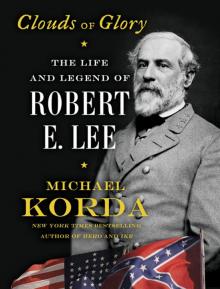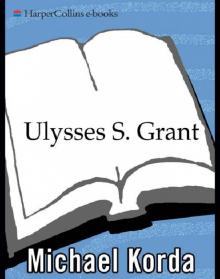- Home
- Michael Korda
Clouds of Glory Page 17
Clouds of Glory Read online
Page 17
General Taylor had at most 15,000 men at his command, the majority of them southern state militiamen or volunteers, stiffened by a small number of regular units, as well as a number of regular officers and specialists like Lee. Lee’s immediate task was to prepare a road so that General Wool could cross the Rio Grande and advance on the “important trading center” of Chihuahua, more than 400 miles west of San Antonio as the crow flies, though Wool was obliged by the absence of any practical direct route through the rugged highlands before him to make a long loop to the south to reach it, nearly doubling the distance he would have to cover.
Lee rode out of San Antonio with Wool’s column on September 28, 1846; this was his first opportunity for active service. He was accompanied by his “faithful” orderly James Connally, an Irish-American civilian who had served him in New York. Connally took care of Lee and also looked after the horses Lee had bought on his way out—Lee’s favorites were Grace Darling, “a chestnut [mare] of fine size and of great power,” which he had purchased in New Orleans; and Creole, “a golden-dun,” which today we would call a palomino, which he bought in Texas. Grace Darling and Creole would both perform miracles for him. Throughout his adult life Lee was an excellent judge of horseflesh, and had a keen eye for a bargain too when it came to buying horses for himself and his family. The only one he would ever splurge on was Traveller, perhaps the most beloved horse in American history, who is buried only a few yards from Lee’s own grave, under an elaborately engraved stone marker.*
Connally must have been a good horseman himself, since he swam Lee’s horses to the beach off the ship, there being no barge to take them ashore; but at first Lee found him something less than an ideal traveling companion, complaining that Connally “starves badly & hunger [they were living on hard crackers and warm water at the time] makes him quite savage.” Connally’s first experience of campaigning in Texas apparently made the New Yorker feel sick and “very low spirited,” hardly surprisingly, given the blazing heat, the enveloping dust, the fierce fleas and flies, and the occasional downpour of rain that created instant mud. Because of the amount of “lime in the soil,” as Lee, always a precise observer of geographical details, points out, the mud “hardens in like mortar” in the sun, and can be washed off only with considerable difficulty—another unwelcome task for Connally.
General Wool’s troops reached the Rio Grande in eleven days, an advance of about eleven miles a day, which was described at the time as “rapid,” though Lee would not consider it to be so fifteen years later, during the Civil War. It was made possible only by the engineers’ effort to level a road of sorts for the artillery and to bridge whatever small streams were in the column’s path. Once at the Rio Grande the column came to a halt and made camp to wait while pontoons were brought up from San Antonio by wagon train. No doubt Lee learned a good deal from this first experience at war—an active reconnaissance by cavalry in advance of the column would have found that the river was running too high and fast to be crossed at most of the fords, and might have led to bringing up the pontoons nearer the head of the column, rather than at the very rear of it. In the rough, semiarid country between San Antonio and the Rio Grande Robert E. Lee got his first practical lesson in the difference between what appears on a map and what the country ahead actually looks like, as well as a lesson in the importance of getting an army’s order of march right for whatever problems lay ahead.
Lee led “a party of pioneers” selected unwillingly from “two regiments of Illinois volunteers,” who had no great desire to exchange a rifle for a spade, pick, crowbar, or shovel, and eight wagons loaded with material and tools—part of a train of nearly 200 wagons that carried enough food and ammunition for nine months, and for which Lee’s pioneers had to smooth out the rocky, makeshift road as they advanced. Even Lee, usually brimming with optimism, complained in his letters that he had too little time and not enough manpower and equipment.
Once the lumbering wagons bearing the pontoons finally caught up with the troops, the river was quickly bridged without opposition, and at General Wool’s orders Lee built “field works” at either end of the bridge, digging in artillery to protect it, something at which he soon became an acknowledged expert. This was cautious, but unnecessary: the only enemy to appear once the column of 2,000 men had crossed the Rio Grande was a Mexican officer “under a flag of truce,” bearing the news that General Taylor had defeated a Mexican force at Monterey, just under 200 miles away to the southeast, and had accepted “an eight-week armistice in return for [its] surrender,” with an armistice line between the opposing armies that could not be crossed during this time. Wool did not consider that the armistice line as explained to him by the Mexican officer prevented him from advancing farther, and marched south to the town of Monclova without meeting any resistance. There he set up his camp and waited three weeks for the armistice to expire. Lee had gained Wool’s complete confidence by the calm, efficient way he sounded fords, cut down steep banks, and built bridges. Lee himself was enjoying the landscape, with “spectacular” mountains visible on the horizon (these were the mountains that prevented Wool from making a direct advance on Chihuahua)—“high country,” as Lee called it, where “the nights are very cold, but the sun at midday scorching hot.” Fortunately, Jim Connally seems to have cheered up, and Lee reports him to be “quite well & sends his remembrances to everybody,” while the horses, to Lee’s relief, “have improved on the journey.” The nights were not only cold but clamorous with a “concert of howling” by “an astonishing number of wolves” which surrounded the camp until dawn.
To Wool’s dismay his men were greeted with “hospitality rather than hostility.” They had marched hard over dry, dusty country for more than two weeks to reach Monclova, then a small, pleasant old town surrounded by verdant hills, where unfamiliar but potent liquor was easily purchased and where a certain number of the local señoritas were disposed to be friendly to the gringo soldiers. Inevitably the discipline of the militiamen and volunteers, never all that firm to begin with, quickly deteriorated. The troops had eagerly expected a glorious battle and a quick victory, instead of which they found themselves encamped on the outskirts of a town full of temptations. For the moment, the enemy was not the Mexicans, but boredom and bickering between the militiamen and the regulars. Wool attempted to keep his men busy with drill and building projects, but they did not respond well to either, and Wool sensibly decided that if he could not provide them with action, the sooner he got them moving again, the better.
Lee, who had been invited to take his meals with General Wool, feared that “Genl. T[aylor] had been betrayed into a mistake in granting” the Mexicans an armistice, which no doubt reflects General Wool’s opinion as well. Lee observed that the mountains to their west were “high, bold & barren . . . bidding defiance to the ascent of man and beast,” which pretty much defined Wool’s problem with reaching his objective. He could not get over the mountains, and it would take forever to move his army around them. In the meantime, he was stuck at Monclova, while Santa Anna was presumably using the time to “collect his strength” at San Luis Potosí, and Wool’s men were consuming their provisions. There was almost no meat available around Monclova, and only a small amount of corn, which the men had to gather for themselves and grind into flour with hand mills. Lee liked the bread this produced, but noted that there was not much of it. “The delay,” Lee wrote to Mary, “has been rather irksome to me [rather] than refreshing, for I am one of those silly persons [who] when I have something to do I can’t rest satisfied till it has been accomplished and it had appeared to me that we have been losing time important to us & granting [a] season of preparation to the Mexicans.” This can hardly have come as news to Mary Lee, who was more familiar than anyone else with Lee’s impatience to get on with a job, whatever it might be, and his preference for swift movement, which would come to define his leadership in the Civil War, when he tried at all costs to keep his army moving and to retain the initiative rather than w
aiting to see what the enemy would do. Any kind of delay was anathema to him.
General Wool and Captain Lee were not the only people who were dismayed by the armistice. Though America rejoiced at Zachary Taylor’s victory at Monterey, which immediately made him a presidential contender, President Polk fumed at the armistice and complained that Taylor had exceeded his authority, as well as committing a political and military blunder. Of course nobody in Washington could appreciate how shaken Taylor’s army, which consisted largely of volunteers, had been by the unexpected ferocity of the fighting at Monterey, but it certainly seems as if Taylor himself was bluffed by the Mexicans, who were in fact defeated and badly disorganized. The attack on Mexico had been allowed to degenerate into that most fatal and un-Napoleonic of military mistakes: dispersing one’s forces rather than concentrating them. Insofar as any single person was responsible for this flawed strategy, Polk was as much to blame as anyone—notoriously stiff and a man for whom political maneuvering was both his lifeblood and his religion, Polk distrusted not only the politically ambitious, folksy Taylor but all his generals, and was himself that most dreaded of wartime political figures, an “armchair general” in the White House.
Attacking Mexico from the north was to take the longest and hardest route to Mexico City; and dividing Taylor’s forces into two columns—the major one attacking toward Monterey and Saltillo under Taylor while Wool’s wandered off in the opposite direction toward Chihuahua for no discernible reason except the belief that it might be a major trading center—made no strategic sense at all. It may be too that Taylor’s early victories and low losses at Palo Alto and Resaca de la Palma gave him and his army a false estimate of just how hard the Mexicans could fight under a leader like Santa Anna. Most of the planning for the war had been done under the assumption that after a few battles south of the Rio Grande the Mexicans would sue for peace and settle for a sensible amount of compensation for California and New Mexico. Indeed that was why the administration had ordered the U.S. Navy to allow Santa Anna through the naval blockade to return to Mexico from Cuba, where he had been spending one of his frequent periods of political banishment and exile. This was a huge mistake. Despite his unapologetic greed Santa Anna was at the same time personally courageous, hugely ambitious, a born leader, and an emotional patriot who not only was acclaimed as, but thought of himself as, the Napoleon of the West. It was second nature to Santa Anna to first encourage, then betray the hope of President Polk and Polk’s advisers that he could be bought cheap. He was as convinced of his own glorious destiny in the endless fight against the hated yanquis as Polk was of his subtlety as a strategist. Both were wrong.
Lee remained “at a loss to account for the reasons that induced Genl Taylor to grant a cessation of hostilities.” He suspected correctly that Santa Anna would use the time to recruit new forces rather than negotiate a peace, and was pleased when General Wool decided to continue his march south on November 18, a day before the armistice expired, since “he was heartily tired of our present camp,” and “Monclova contained nothing of interest” to him. He noted that the residents of Monclova were no longer as friendly as they had been, either—not surprisingly after their three weeks of dealing with an enemy army camped outside their city.
That night a messenger arrived from General Taylor informing Wool that the president had terminated the armistice and that the expedition to Chihuahua was to be abandoned, news which Lee greeted with relief, since he had never been convinced that “any good would come from it except conquering distance.” Taylor had “pushed forward” Brigadier General William J. Worth with 3,000 men to take Saltillo, southeast of Monterey, and intended to follow him with the bulk of the army. Worth was a fiery hero of the War of 1812 and had been commandant of cadets when Lee was at West Point; “a splendid horseman, he was physically the ideal soldier,” and his fame, though now eclipsed, was such that several places were named after him: Fort Worth and Lake Worth in Texas; Lake Worth in Florida; Worth, Illinois; and Worth County, Georgia.*
Still, General Wool did not move until November 24. His orders were to advance south to Parras, where he would be in a position to support General Worth in Saltillo, a march of over 160 miles, and to abandon his present line of communication for one to Camargo—which was like plunging into the unknown without a lifeline. When Wool’s army reached its new destination it would be almost 400 miles deep in enemy territory, marching toward the nearest place where it could be resupplied. This was a daring move considering that the men had been living off the contents of their supply train for the best part of a month.
Lee, with his pioneers, moved ahead of the army, preparing the makeshift road, which in some places was hardly more than a rutted track, for the artillery and the wagon train. Lee roughed it with his pioneers. Two days out of Monclova he wrote to Mary, “We . . . reached Castana in a terrible norther, where we encamped in a cornfield & appeared as if it would be swept away by the fierce wind. I could scarcely get my tent up, & when up, keep it so. . . . We could of course cook nothing, & I was out till dark reconnoitering. We arrived on the ground under a scorching sun. The wind [got] up while they were laying out the camp & became so severe that but a few tents were erected before dark. By the time I got mine up, it was so cold, that when I took to the saddle again I was uncomfortable [even] buttoned up in my greatcoat. So sudden are changes out here. On resuming our march next morn[ing] at sunrise there was plenty of ice in the stream. The thermometer stood at 23: had [to] lead my horse & walk a mile or two to warm my feet. We marched that day 21 miles before reaching water & encamped on a barren plain where there was no wood or grass. . . . We march tomorrow at 5 a.m. Reveille at 3 & have to go 30 miles to reach water. A long march. I have seen all my animals fed & comfortable for the night & men too.” Lee also reported that Santa Anna was rumored to be at San Luis Potosí and that “when he received the message from Genl. T[aylor] abrogating the armistice, returned for answer that he could never make peace so long as there was an armed American on the soil of Mexico . . . & that we should now have war not only to the knife, but to the handle also.”
A more important rumor was that the U.S. Navy had taken the fort of San Juan de Ulúa, which commanded the harbor of Vera Cruz, and that, in Lee’s words, “our government would push a strong force from Vera Cruz towards the City of Mexico,” forcing Santa Anna to give up San Luis Potosí and make peace—or a last stand in the Mexican capital.
Lee was correct, but premature by four months. This was in fact exactly what President Polk intended to do, now that he realized the many obstacles facing General Taylor as he advanced south. What had held Polk up was the enormous task of gathering men, artillery, and equipment for a seaborne invasion of Mexico—the most ambitious American amphibious operation to date. A still more difficult decision was that Polk had to choose who would command it.
The logical choice was General Winfield Scott, the commanding general of the U.S. Army,* not only its most competent and most senior officer, but a national hero, indeed a national institution, and the author of the plan to take Vera Cruz and march directly on Mexico City in the first place.
Unfortunately, the one general in the U.S. Army whom President Polk disliked and mistrusted more than he did Zachary Taylor was Winfield Scott; and Scott had the additional disadvantage from the president’s point of view that his headquarters was only a few steps away from the White House. Scott was a huge (at six feet five inches he towered a foot above President Polk) and omnipresent personality in Washington, D.C., overshadowing almost everyone else by his size, his girth, his elaborate uniforms, his taste for military ceremony, and, of course, his legendary reputation—he was greatly admired by that keenest judge of military ability, Field Marshal the Duke of Wellington, the aged victor of Waterloo.
Scott was a larger-than-life figure, the glow of his glory casting into the shadow more ordinary political figures. Like Zachary Taylor, Scott had his eye on the White House—neither general disguised his presidential ambitio
n—but while Scott was a Whig, a member of the party opposing the president’s, it was not clear to anyone which party’s nomination Taylor would seek. Polk vacillated between the desire to get Scott out of Washington and into the field, where he might possibly commit a blunder that would tarnish his reputation, and the fear that Scott might win a victory which would make him even more of a national hero than he already was.
Unlike Polk, whose personality has been described as “drab,” Scott was capable of a kind of elephantine charm reinforced by military glamour. He loved company and despite his air of lofty superiority enjoyed a certain degree of popularity. He was also apt to make serious gaffes on the subject of the president. Scott would apologize for them later in a grandiose and oleaginous manner that the president found insufferable. The temptation to send him to Vera Cruz and get him out of the way—and, more important, out of Washington—was almost irresistible to Polk. As for Scott, he regarded command of the expedition as no more than his due.
Polk sought for a way out of his dilemma, and found it in his fellow Democrat Senator Thomas Hart Benton of Missouri (known as “Old Bullion” for his opposition to paper money, and a staunch advocate of western expansion). Polk asked the senator to command the Vera Cruz expedition. Senator Benton had served as an aide-de-camp to Andrew Jackson in the War of 1812, but had not worn a uniform since then. He made no claim to being a professional soldier—the highlight of his experience under fire was a duel in which he had killed his opponent—but this did not prevent him from seriously considering the role. As overbearing and arrogant as General Scott, Benton had served five terms as a senator and was one of the most respected figures in national politics—his eminence was such that not even Scott could have objected to Benton’s being placed in command. Fortunately for Scott, however, the senator would not consider taking command of the expedition unless he was given the rank of lieutenant general. Since this would have given Benton one more star than Scott, the army’s commanding general, and also make Benton the first American since George Washington to hold that rank, even Polk was obliged to throw in the sponge and finally appoint Scott to command one of the most ambitious military operations in the history of the United States.

 Passing
Passing Another Life
Another Life Clouds of Glory
Clouds of Glory Hero: The Life and Legend of Lawrence of Arabia
Hero: The Life and Legend of Lawrence of Arabia Cat People
Cat People Hero
Hero With Wings Like Eagles: A History of the Battle of Britain
With Wings Like Eagles: A History of the Battle of Britain Ulysses S. Grant
Ulysses S. Grant